Weekly Fishing Report: April 4
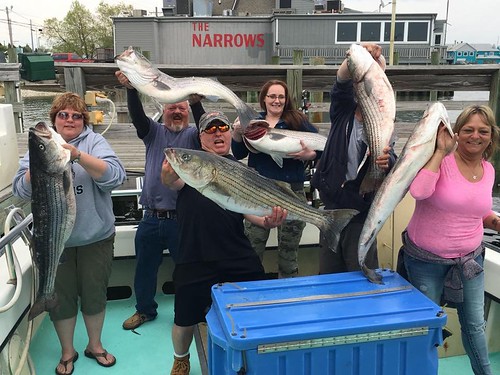
This impressive catch of trophy striped bass is from last year’s trophy season (2017). Photo by Geri Shupe
It continues to be a chilly spring and there seems to be no immediate end to it. We’re a week into April and water temperatures are considerably lower than usual — in the mid-40s in the tidal rivers and bay. By comparison, last April 5, the bay was just about 50 degrees and the tidal rivers were in the upper 50s.
Even so, just as trout fishermen anticipated the opening day of trout season last Saturday, striped bass fishermen are crossing off the days on their calendars until the opening of the trophy striped bass season April 21.
Before we get into this week’s fishing report, I want to remind everyone that they can submit their own fishing reports and photos to the Maryland Angler’s Log. To post a report, please email your name, hometown, photos, location and additional content for your report. All information is optional, but encouraged.
Many anglers have seen discussions of the new proposed striped bass regulations concerning a new 19-inch minimum size and the use of circle hooks when chumming and live-lining. Here’s what you need to know:
The department has submitted an emergency action in an effort to change striped bass regulations starting May 16. The emergency action has not been formally approved yet, and we are hoping to get confirmation soon. The new proposed regulation includes the requirement to use circle hooks when chumming and live-lining. J-hooks with a ½-inch gap or less (between shank and point, typically 1/0 or smaller) can be used when NOT chumming or live-lining with live fish baits. This includes fishing with baits such as dead whole or cut fish, crabs, worms or processed bait, such as fishbites, which many people use when bottom fishing for small fish such as spot, croaker and perch. So, you can use your small J-hooks such as size #2, #4, and #6 if you are just bottom fishing and not chumming or using live fish baits. Circle hooks of any size can be used for bait fishing and are mandatory for chumming and live-lining.
Stay tuned to our website for any updates on when those regulations go into effect.
If this weather pattern continues it could be a slow opening day for post-spawn striped bass out in the bay — which is not uncommon, and as we all know just being out on the Chesapeake fishing with friends and family can be reward enough. If I had to sparingly use my vacation time or pocketbook, I’d focus on the first and second week of May. Thanks to a borrowed electronic water temperature meter, a keen nose (one that can smell the fish oil) and an eye for spawning activity, we will do our best to keep the latest information flowing on striped bass spawning progress.
Weekly Fishing Conditions Forecast Summary: April 3-10
Unstable weather for the first full week of April will swing from windy and warm to cool with a chance of rain or snow for the second half of the week. These conditions will provide limited warming of Maryland bay waters for gamefish preparing to spawn here in the next several weeks. The Maryland portion of the bay continues to have suitable oxygen conditions from surface to bottom.
While waters are still cool, surface waters can be slightly higher, so anglers may want to scan these shallower areas for fish during moving water and low light conditions after the sunset and before sunrise. As reported from the National Oceanic and Atmospheric Administration buoys, main bay surface water temperatures are holding at 46 degrees at Annapolis, Gooses Reef and Point Lookout. In addition, expect slightly warmer temperatures in smaller, dark-bottomed shallow creeks. As tides empty the water in these warm creeks, look for nearby structure to target feeding gamefish. Expect normal flows for streams and rivers entering Maryland’s portion of the bay. There will be above average tidal currents Tuesday through Thursday as a result of the full moon this past Saturday.
For the full weekly fishing conditions summary and more detailed and up-to-date fishing conditions in your area of the bay, be sure to check out Eyes on the Bay’s Click Before You Cast.
Upper Chesapeake Bay
Low water discharge rates from the Conowingo Dam have done much to create good water clarity in the Susquehanna River and Flats areas, where water temperatures are holding around 43 degrees. The catch-and-release fishery is underway and as usual, it starts off with a lot of smaller male striped bass. It is not uncommon to catch dozens of smaller male striped bass per outing when conditions are right. There are of course some large females lurking in the area. Although water temperatures are still to chilly for spawning the first hickory shad have been seen in the Susquehanna this week. Water temperatures need to be in the mid-50s before we can expect any action at Deer Creek from the hickory shad.
There has been some catch-and-release action for striped bass along channel edges near Love Point, the mouth of the Magothy and near the Bay Bridge this week. The water temperature is still a chilly 45 degrees so jigging for medium-sized striped bass can be slow at times. Shore-bound anglers have been showing up at the tip of Sandy Point and drowning bloodworms in what is known as “the rip.” A few fish are being caught and released, and as one can imagine this catch-and-release fishery poses some challenges. First and foremost, heavy surf fishing gear is needed — leave the medium spinning outfits at home. Also, circle hooks are a must and fish need to be met in the shallow water and not dragged up on the sand, so knee boots are needed. Lastly, if a bragging picture is taken, support the fish horizontally and do it quickly to lessen organ damage and stress to the fish.
Fishing for white perch in the upper reaches of the region’s tidal rivers continues to be popular this week. The white perch have reached their spawning areas and are providing good fishing opportunities. The Chester River at the Millington area, the Northeast River, and the upper Bush and Magothy rivers have been popular and have all been providing good fishing. Shad darts tipped with a piece of minnow, bloodworm or a bare shad dart have been effective. The 1/8 ounce size is easy to handle on an ultralight spinning outfit and some like to place a 1/32 ounce as a dropper. Grass shrimp or bloodworm on a slip bobber rig also work well. Crappie can also often be part of the mix.
Middle Bay Region
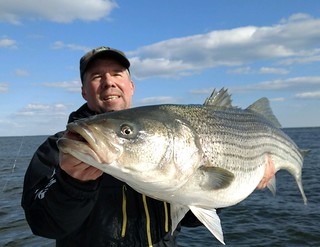
Travis Long sent us this nice picture of a healthy looking pre-spawn striped bass caught while jigging. Photo courtesy of Travis Long
When the sun shines and winds are slight, anglers have been venturing out on the bay practicing for trophy striped bass season by catching and releasing a few large fish. Surface water temperatures are about 46 degrees in the major portions of the bay and slightly cooler down below, so most of the larger striped bass will be caught off planer boards. The steep channel edges are usually the best place to try and remember no more than six rods may be deployed and lures must have the barbs ground off or mashed down flat and stinger hooks are prohibited.
The warm water discharge at the Calvert Cliffs Nuclear Power Plant continues to be the best place to try jigging for a trophy-sized striped bass. Most are using large soft plastics, often in the 8-inch size or better. The discharge plume is popular and it takes some patience to line up for a drift. Others have been surveying channel edges in the region looking for suspended fish on their depth finders and having some luck with various sizes of striped bass by jigging with soft plastics.
White perch area are actively spawning now in the region’s major tidal rivers and fishing has been good this week in the spawning areas. The upper Choptank River above Greensboro has been one of the most popular areas within the region. The white perch can be found all the way up to the gauging station at Red Bridges. Casting small shad darts or using bloodworms or grass shrimp under a slip bobber have been common ways to fish. Alewife herring can also be found in the same spawning areas and hickory shad are right behind them and they will take shad darts also, providing some fun catch-and-release action.
Lower Bay
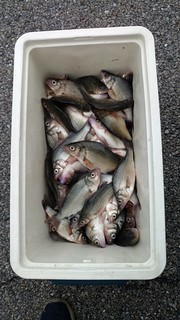
Greg Shelton shows of his catch of white perch caught at Wayson’s Corner. Photo courtesy of Greg Shelton
Boats have been venturing out from ports in the lower bay carrying anglers out to the steeper edges of the shipping channel where they have been trolling and practicing some catch and release fishing for striped bass. The action has been a little slow but it does offer the chance to get out on the water and shake the bugs out of the boat and fishing gear. Others have been jigging near channel edges on suspended fish, but that action also tends to be slow. The catch and release action in the tidal Potomac River has been better in the areas above Fort Washington. Most of this action focuses on casting jigs and swimbaits.
There are some new cobia regulations this year. The season is open June 1 through Sept. 30. It is closed all other dates. Recreational anglers may keep one cobia per person per day or up to three cobia per vessel per day if there are three or more individuals on the vessel. The recreational minimum size for cobia is 40 inches total length.
Fishing for white perch continues to be very good in the Nanticoke, Wicomico and Pocomoke rivers on the Eastern Shore. The tributaries to the Potomac such as the Wicomico at Allen’s Fresh and the upper Patuxent at Wayson’s Corner have been providing great fishing for white perch this week. Fishing with bottom rigs or slip bobber rigs baited with bloodworms or grass shrimp have been favorite ways to fish or casting shad darts.
Fishing for blue catfish continues to be excellent in the tidal Potomac, with some of the best fishing within a few miles of the Wilson Bridge. Many are taking advantage of this fishery to stock up on superb eating fillets since it is not hard to fill up a cooler with a mess of tasty fillets.
The crappie fishery has really taken off in the past week in the tidal Potomac, with large pre-spawn female crappie being found around fallen tree tops, marina docks and deep structure. Minnows or small jigs under a bobber are the most popular way to fish for them. The tributaries in the Fort Washington area have some of the best crappie fishing to be found anywhere.
Freshwater Fishing
Opening day of the traditional trout season was enjoyed by many this past Saturday due in no small part to the efforts of the hatchery and stocking crews. Crews were out in force as early as April 2 performing additional stockings, and their efforts continue through this week and weeks to come. There is lots of fun and exciting trout fishing in the future for everyone. Everyone is urged to keep tracking of the daily stockings on the trout stocking website.
We received a couple of pictures that were taken March 31 on the traditional opening day of trout season. The pictures tell a story and experience that is open to anyone who is looking for a different trout fishing experience — the kind of setting that can be found at our fly fishing only or catch-and release trout management waters: peace, no crowds and a fun and fulfilling trout fishing adventure. Thanks to John Mullican for sharing a different twist to opening day with us.
Although it has been a very chilly spring so far water temperatures are slowly creeping up. This can be especially true in small ponds. As water temperatures in the freshwater ponds, lakes, reservoirs and tidal waters warm, largemouth bass will be entering a pre-spawn phase of activity. This is good news as largemouth bass are actively feeding to build up body stores for the strenuous spawning phase to come soon. Among their favorite foods are crayfish that have spent the winter nestled down in deeper waters for the winter and are now beginning to migrate to shallower areas. Crankbaits, craws, grubs and jigs are excellent baits to use in the transition areas between deep and shallow areas, especially around structure. Spinnerbaits, flukes, stick worms and swimbaits can also be a great choice in the shallower end of the transition zones. Expect the smaller male largemouth bass to be shallower as they will be the first ones to arrive at the spawning areas.
As water temperatures approach the typical spawning water temperatures of 51 degrees for crappie, these fish are schooling up near deep structure. Fallen tree tops, sunken wood, bridge piers, marina docks are all good places to find pre-spawn crappie. Fishing a small jig and or minnow under a slip bobber is the most popular way to catch them. If you can find the room to back cast a Mickey Fin type streamer or even a slowly retrieved Clouser minnow with a sinking tip line can offer some fun fly rod action.
Atlantic Ocean and Coastal Region
Ocean water temperatures nearshore are about 43 degrees this week. There is not a whole lot going on fishing-wise except tautog fishing on the offshore wreck and reef sites. The 2018 tautog season in Maryland will be open until May 16 and then will be closed until June 30. It will then reopen from July 1 thru Oct. 31 with a two fish per day creel limit. From Nov. 1 through Dec. 31, the daily creel limit will go to four fish per day. A 16-inch minimum size remains.
Sea bass will remain closed until May 5 with new regulations announcements expected by then.
Coastal angler should also be aware of the new cobia regulations this year. The season is open June 1 through Sept. 30. It is closed all other dates. Recreational anglers may keep one cobia per person per day or up to three cobia per vessel per day if there are three or more individuals on the vessel. The recreational minimum size for cobia is 40 inches total length.
Recreational flounder regulations for summer flounder will be a minimum size of 16.5 inches for 2018, four flounder per person per day and the season will run from April 1 thru Dec. 31.
“Poets talk about ‘spots of time,’ but it is really fishermen who experience eternity compressed into a moment. No one can tell what a spot of time is until suddenly the whole world is a fish and the fish is gone.” – Norman Maclean
 ABOUT THE AUTHOR Keith Lockwood has been writing the Fishing Report since 2003 and has had a long career as a fisheries research biologist since 1973. Over the course of his career he has studied estuarine fishery populations, ocean species, and over a decade long study of bioaccumulation of chemicals in aquatic species in New Jersey. Upon moving to Oxford on the eastern shore of Maryland; research endeavors focused on a variety of catch-and-release studies as well as other fisheries related research at the Cooperative Oxford Laboratory. Education and outreach to the fishing public has always been an important component to the mission of these studies. Keith is an avid outdoorsman enjoying hunting, fishing, bird dogs, family and life on the eastern shore of Maryland.
ABOUT THE AUTHOR Keith Lockwood has been writing the Fishing Report since 2003 and has had a long career as a fisheries research biologist since 1973. Over the course of his career he has studied estuarine fishery populations, ocean species, and over a decade long study of bioaccumulation of chemicals in aquatic species in New Jersey. Upon moving to Oxford on the eastern shore of Maryland; research endeavors focused on a variety of catch-and-release studies as well as other fisheries related research at the Cooperative Oxford Laboratory. Education and outreach to the fishing public has always been an important component to the mission of these studies. Keith is an avid outdoorsman enjoying hunting, fishing, bird dogs, family and life on the eastern shore of Maryland.

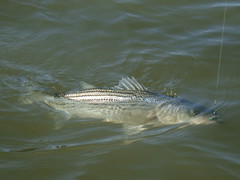

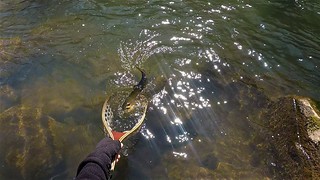
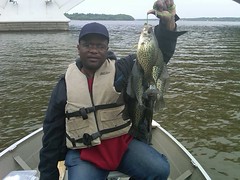
 1-888-373-7888
1-888-373-7888 233733
233733